Get Started with Your Implementation
Learning Objectives
After completing this unit, you’ll be able to:
- Describe the general functionality of an order management system.
- Describe the benefits of Salesforce Order Management.
- List the steps you need to take to get your org ready for Salesforce Order Management.
- List the Salesforce Order Management features and settings you need to enable and configure.
- Explain how person accounts work with Salesforce Order Management.
What’s Order Management?
Ursa Major Solar, a solar device manufacturer located in the American Southwest, is all about energy efficiency and keeping a small footprint. It’s already implemented Salesforce Commerce. It wants the added benefits of a Salesforce-based order management system that supports its commerce stores—from product purchase all the way to fulfillment and servicing.
Maria Jimenez, Ursa Major Solar’s admin, is tasked with implementing an order management system—namely, Salesforce Order Management. Before she starts, she wants to learn more about order management systems in general and about Salesforce Order Management in particular.

Order processing typically starts within a store application when the customer places an order. The application creates supplemental records such as order items, adjustments, shipping, and summaries, checks inventory, and processes the payments.
The order management system takes over for the fulfillment process, making sure the customer receives what they ordered. It also does the servicing, such as returns, appeasements, and reships; and maintains customer history.
These are the typical steps of an order processing system.
-
Allocation: The system determines which location or locations will fulfill the order.
-
Fulfillment: A person or system confirms shipping details, generates an invoice, then picks, packs, and ships the order.
-
Servicing: If needed, a person or system cancels, discounts, returns, reships, or exchanges order items.
Salesforce Order Management
Salesforce Order Management delivers a powerful workflow with order allocation, fulfillment, and servicing features. It provides a single view of orders, actions taken on orders, and order history. It provides sample fulfillment packages that include flows, processes, and Apex classes to help Maria implement her system.
Salesforce Order Management works with these Salesforce products.
- Salesforce Commerce
- B2B Commerce
- D2C Commerce
- Salesforce B2C Commerce
- Service Cloud
- Store Fulfillment mobile app
- Omnichannel Inventory
- Salesforce Payments
Order Data
A Salesforce Order Management process looks something like this.
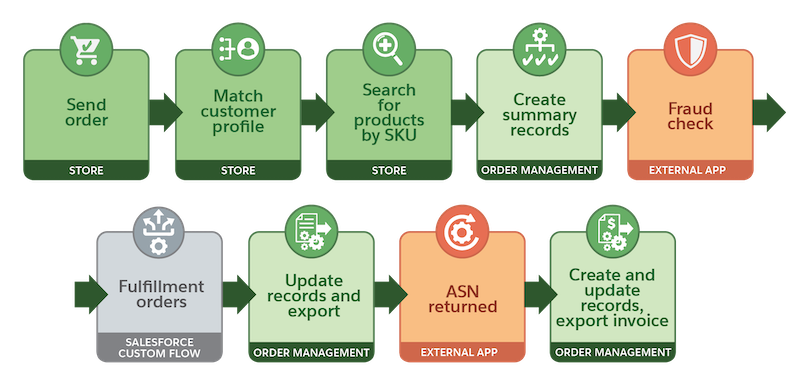
- The Salesforce Commerce store (B2B or D2C):
- Creates a cart.
- Matches the customer profile with a customer account in Salesforce.
- Searches for each ordered product using the product stock keeping unit (SKU).
- Creates an order.
- Order Management creates summary records for the order and its related records.
- A third-party provider (via a custom integration) performs a fraud check.
- A custom flow creates fulfillment orders and fulfillment order products and assigns them to fulfillment locations based on order delivery groups, inventory, and other criteria.
- Order Management updates summary record quantities and exports fulfillment data.
- An external provider returns an advance shipping notice (ASN).
- Order Management:
- Creates shipment records and changes the fulfillment order status to Fulfilled.
- Creates invoices and places calls to the payment provider to ensure funds.
- Updates quantities and statuses on the associated summary records and exports the invoices to an enterprise resource planning (ERP) system.
Get Started
An Order Management license gives Maria full access to Order Management functionality. The Order Management product that comes with D2C Commerce has limited functionality, and some instructions differ (as noted in this module).
Here are the general steps Maria takes to implement Order Management with B2B and D2C Commerce.
Step |
Task |
|---|---|
1 |
Prepare the org for Order Management. |
2 |
Configure the tax display. |
3 |
Configure fulfillment. |
4 |
Configure payment processing. |
5 |
Import historical order data. |
Prepare Your Org
Here’s how Maria prepares her org for Order Management.
Step |
Task |
|---|---|
1 |
Make sure Lightning Experience is enabled on the org. |
2 |
Set up features and settings in the org to work with Order Management. |
3 |
Configure access and permissions. |
4 |
Configure field-level security settings and users and permissions. |
5 |
Set up flows. Order Management and Salesforce Flow work well together, which makes it easy for you to create manual and automated functions in the org. |
In this unit, Maria focuses on the first two tasks.
Enable Lightning
You must use the Lightning interface to access OrderManagement. It’s not supported on Salesforce Classic or Mobile.
Configure Features and Settings
Maria needs to enable and configure these Order Management features and settings.
- Person accounts (required for D2C Commerce only)
- Multiple currencies (optional)
- Admin settings
Enable Person Accounts
With Salesforce Commerce, Maria can represent shoppers via person accounts or standard business accounts. While person accounts are optional with B2B Commerce, she must use them with D2C Commerce.
You can't turn off the person accounts feature on your org, but you can reconfigure Order Management to stop using it. This irreversible process changes the database structure of your org.
A shopper represented by a business account is also represented by a contact. A person account is a special type of account record that includes data normally found in contacts. If Maria uses a person account, she can’t work directly with the contact in the Salesforce UI. Instead, she accesses contact data via special fields in person accounts. Person accounts let her work with a single record instead of a separate account and contact record for each customer.
Order Management always uses standard accounts and contacts to represent business (B2B) buyer accounts, even if you enable person accounts. It only uses person accounts for individual shopper accounts. Before Order Management can use person accounts, Maria must activate the Person Accounts for Shoppers admin setting to represent individual customers with person accounts.
When Maria enables person accounts in her org, the system creates two default record types for the account object: business account and person account. A business account is just a standard account.
Once she enables person accounts in her org, she can’t disable them. However, she can configure Order Management to handle individual shoppers as business accounts instead of person accounts by turning off the Person Accounts for Shoppers setting for an individual.
Before she can enable person accounts she must create a support case, and allow five business days for Support to complete the case.
In this module, we assume you are a Salesforce administrator with the proper permissions to implement Order Management. If you’re not a Salesforce administrator, that’s OK. Read along to learn how your administrator would take the steps in a production org. Don't try to follow these steps in your Trailhead Playground. Order Management isn't available in the Trailhead Playground.
Here’s how Maria enables person accounts.
- Open your org.
- From Setup, in the Quick Find box, enter
Profiles, and select Profiles.
- Select System Administrator.
- Scroll to the Record Type Settings section, find Accounts, and click its Edit link.
- In the Selected Record Types section, move --Master-- to the Available Record Types box.
- Move Business Account and Person Account to the Selected Record Types box.
- Set the Default Record Type and the Business Account Default Record Type to Business Account.
- Set the Person Account Default Record Type to Person Account.
- Click Save.
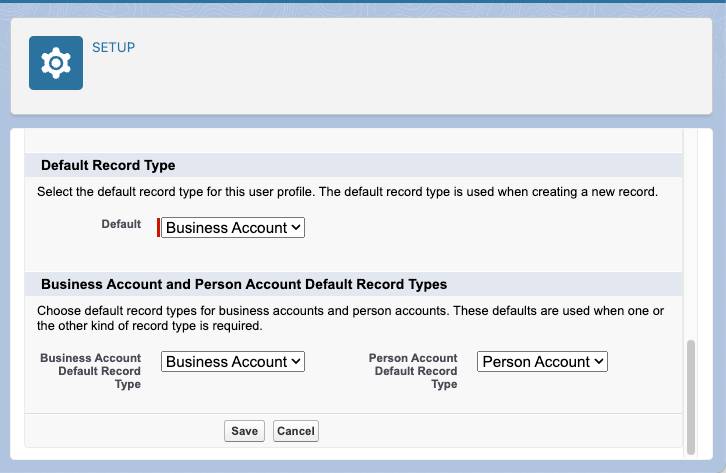
Give Access to Person Accounts
Maria wants to use person accounts to represent shoppers, so she needs to give the appropriate permission sets the ability to access person accounts. Here’s how she does it.
- From Setup, in the Quick Find box, enter
Permission Sets, and select Permission Sets.
- Clone the permission set that controls access for your Order Management users:
Order Management 1Commerce User - Enter a label name.
- Click Save.
- Select the newly cloned permission set.
- In the Apps section, click Object Settings.
- Select Accounts.
- Click Edit.
- In the Account: Record Type Assignments section, select Business Account and Person Account.
- Click Save.
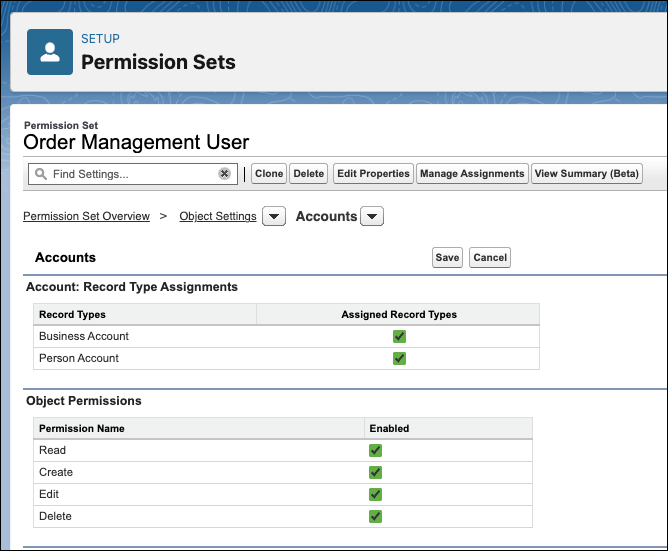
Enable Multiple Currencies
Maria wants to use multiple currencies with her org because her sites support multiple currencies. Here’s how she enables multiple currencies.
- From Setup, in the Quick Find box, enter
Company Information, then select Company Information.
- Click Edit.
- Ensure that your selected currency locale is the default currency that you want to use.
- Enable Activate Multiple Currencies.
- Click Save.
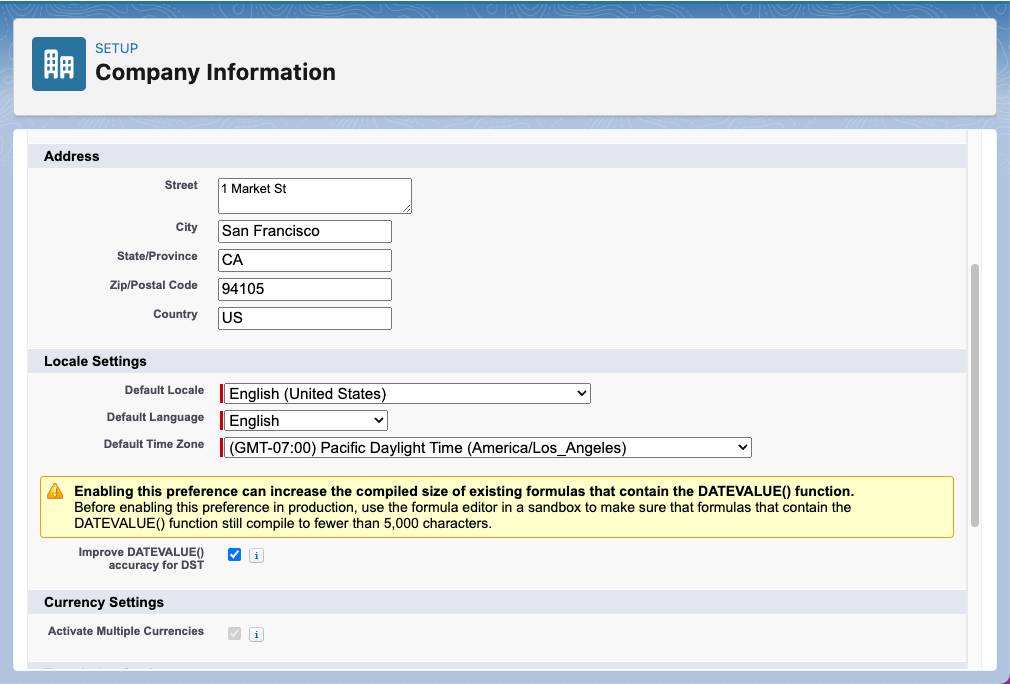
Enable Admin Settings
Here’s how Maria configures the admin settings required for Order Management.
- From Setup, in the Quick Find box, enter
Order Settings, then select Order Settings.- Select these: Enable Orders, Enable Negative Quantity, Enable Zero Quantity, Enable Enhanced Commerce Orders.
- Select Enable Optional Price Books for Orders (optional).
If you’re using D2C Commerce, you must turn on this feature.
- Click Save.
- Log out of the org and log back in, or refresh the page.
- From Setup, in the Quick Find box, enter
Order Management, then select Order Management.
- Activate the Order Management toggle.
Order Management can take several minutes to activate. If you don’t see the Order Management app in the App Launcher, wait a few minutes and refresh the page.
- From Setup, in the Quick Find box, enter
- If you’re using person accounts to represent individual shoppers, activate the Person Accounts for Shoppers toggle.
Changing this setting can take up to an hour because of the way it’s cached.
- Click Save.
- Select these: Enable Orders, Enable Negative Quantity, Enable Zero Quantity, Enable Enhanced Commerce Orders.
- Log out of the org and log back in, or refresh the page.
- From Setup, in the Quick Find box, enter
Order Management, then select Order Management.
- Activate the Order Management toggle.
Order Management can take several minutes to activate. If you don’t see the Order Management app in the App Launcher, wait a few minutes and refresh the page.
- From Setup, in the Quick Find box, enter
- If you’re using person accounts to represent individual shoppers, activate the Person Accounts for Shoppers toggle.
Changing this setting can take up to an hour because of the way it’s cached.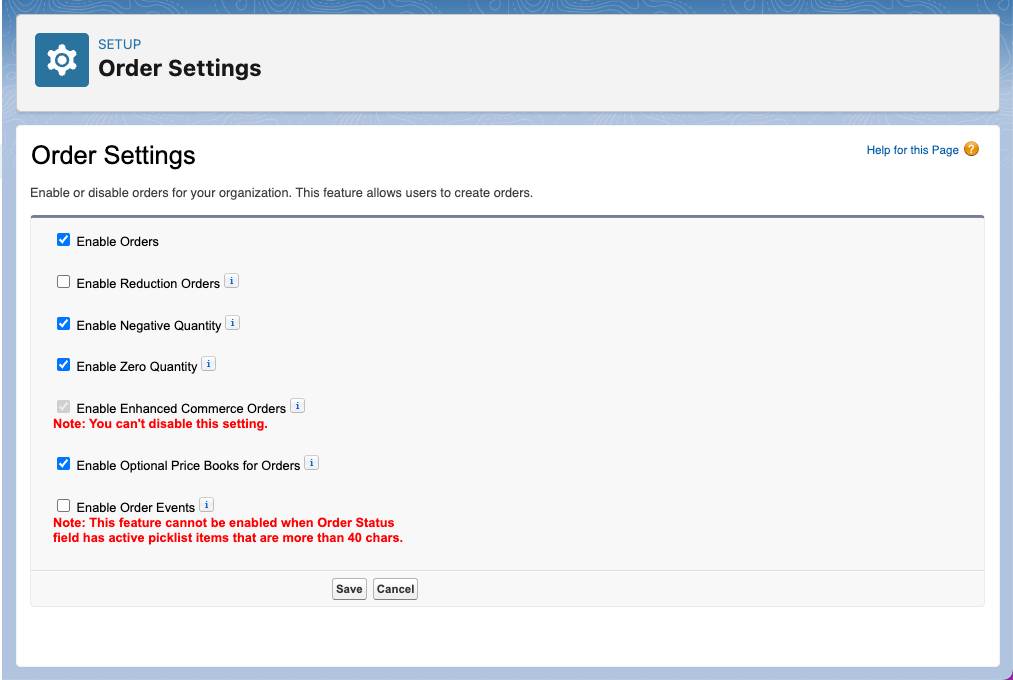
Next Steps
In this unit, you learned about order management and explored Salesforce Order Management basics. You also started preparing your org for an Order Management. Next, configure Order Management access and permissions.
Resources
- Salesforce Help: Use a Person Account to Create a Buyer for B2B Stores
- Salesforce Help: Enable Currencies
- Salesforce Help: Manage Multiple Currencies
- Salesforce Help: Reduction Orders
- Salesforce Help: Tailor Business Processes to Different Users Using Record Types
- Salesforce Help: Enable Orders Without Price Books
- Salesforce: Salesforce Order Management Implementation Guide
